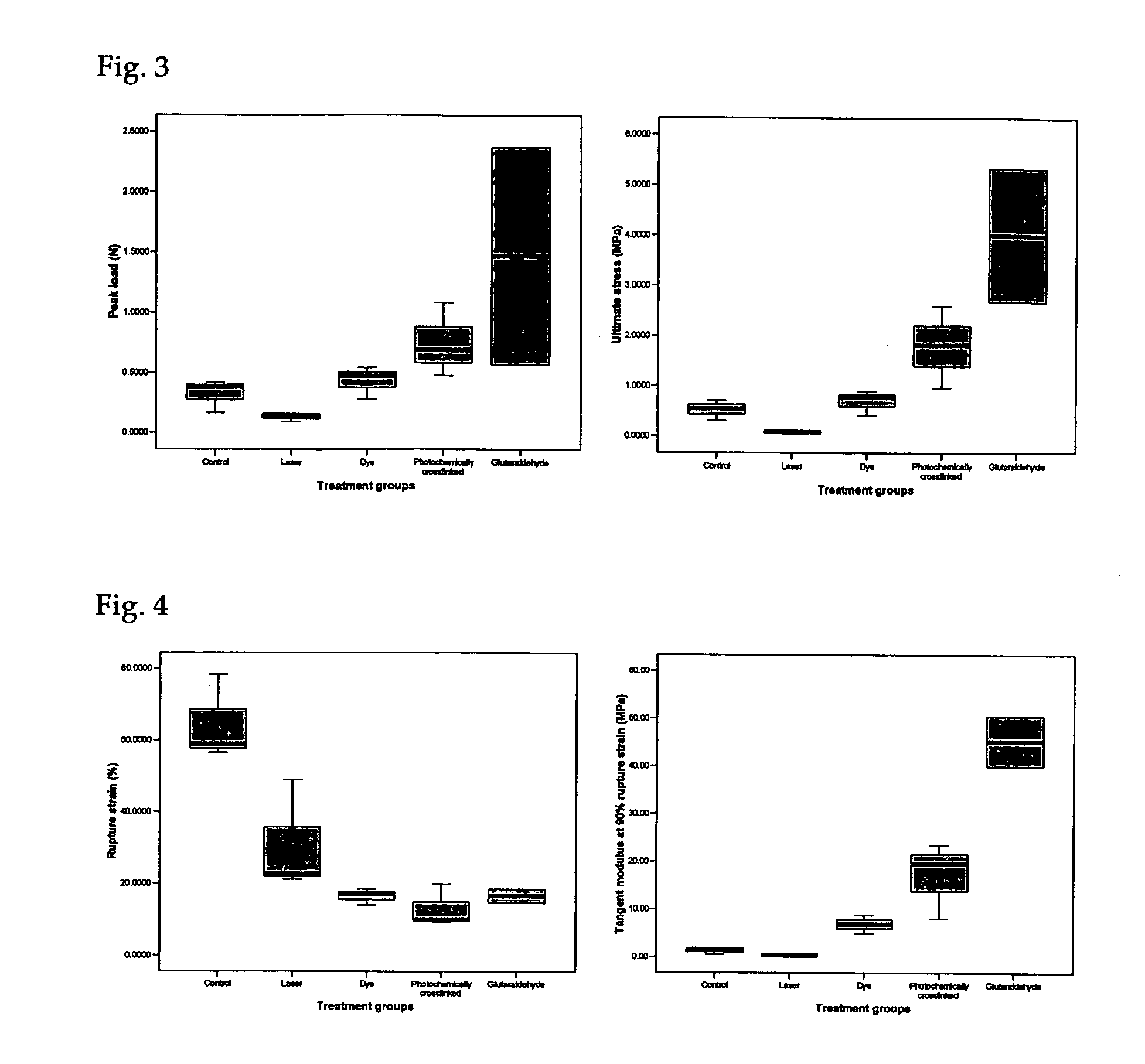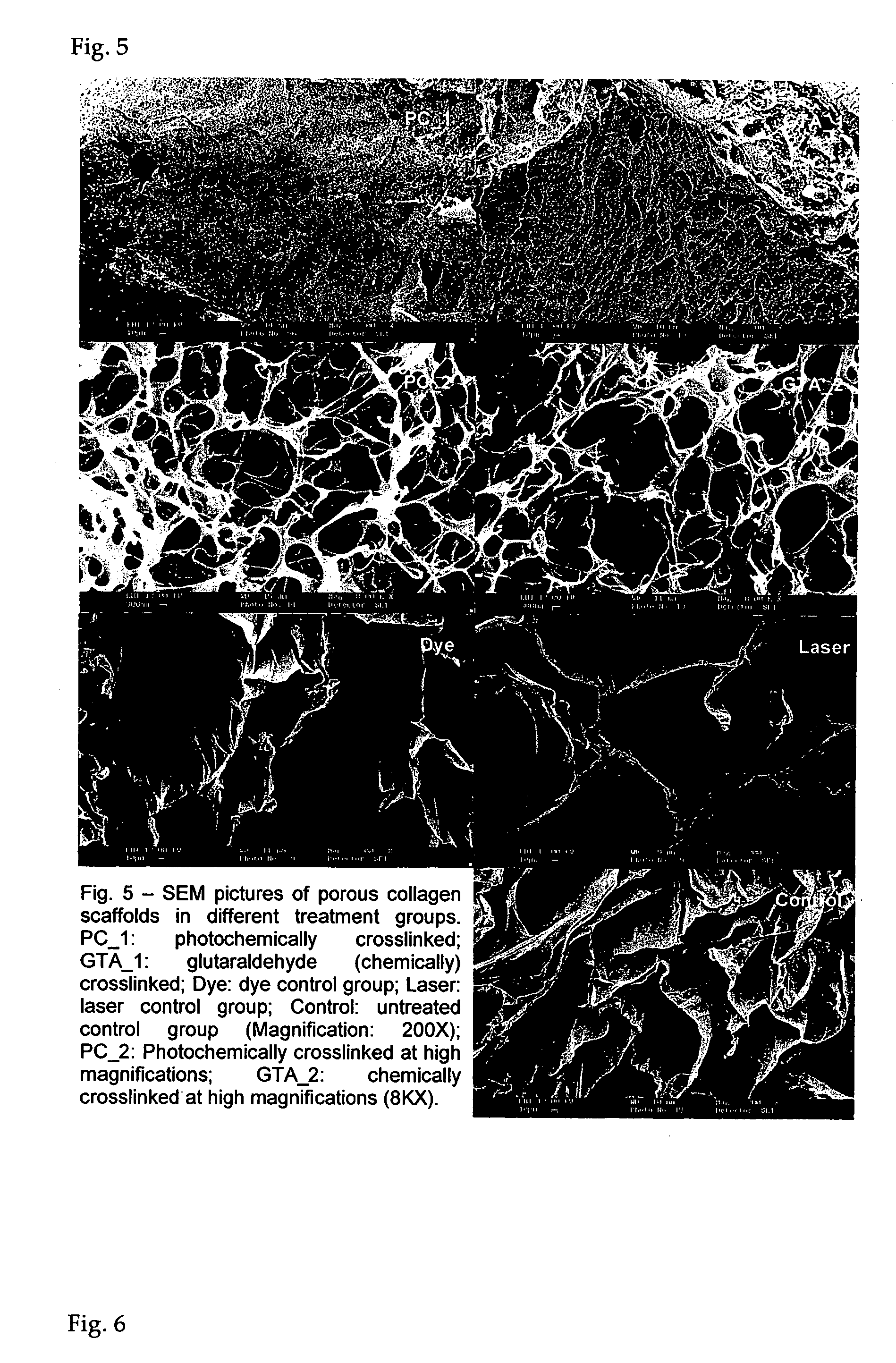Photochemically crosslinked collagen scaffolds and methods for their preparation
a photochemical and crosslinked technology, applied in the field of crosslinked collagen scaffolds, can solve the problems of unprocessed collagen not having sufficient mechanical properties to be useful, unprocessed collagen is also difficult to manipulate and put sutures through, unprocessed collagen is highly water swellable, etc., to achieve the effect of enhancing strength, and reducing the swelling ratio
- Summary
- Abstract
- Description
- Claims
- Application Information
AI Technical Summary
Benefits of technology
Problems solved by technology
Method used
Image
Examples
example 1
Fabrication of Collagen Scaffolds
[0060] An acid-soluble rattail collagen type I solution at a concentration of 4 mg / ml is degassed and 1.5 ml of it is carefully laid down onto a plastic container 1.5 cm in diameter, and any air bubbles generated are removed. The pH of the solution is raised by placing the solution in a chamber containing ammonia vapor for 30 minutes. Opague solid collagen gel is formed from colorless solution. A collagen matrix of approximately 7.5 mm thick and 15 mm diameter is obtained and then thoroughly rinsed with water. The gel is immersed in rose Bengal at a concentration ranging from 0.000078125% to 0.01% for 2 hours. Control collagen gel is immersed in water. Excess photosensitizing reagent is removed by thorough rinsing with water. Fully swollen collagen gel is then photochemically crosslinked by exposing it to an argon laser (Coherent Medical, Ultima 2000). Laser pulses of is duration and a power of 0.2 W were used. The total energy input was from 12.5 J...
example 2
Fabrication of Collagen Scaffolds by Lamination of Multiple Layers
[0061] Crosslinked dry collagen scaffold prepared by the method of Example 1 is rehydrated in PBS (pH7.4) or water for 30 minutes. The rehydrated collagen membrane prepared as in Example 1 is rinsed in water or other isotonic solution and the water on the surface of the rehydrated scaffolds is removed by blotting dry using kimwipes or other absorbants. The scaffold is carefully laid down at the bottom of a container for reconstitution of collagen gel as described in Example 1. The container has a dimension of 15 mm diameter and approximately 7.5 mm thick. 1.5 ml of degassed acid-soluble rattail collagen solution type I at 4 mg / ml is carefully casted onto the collagen membrane. Any air bubbles generated during this process are removed. The membrane-containing collagen solution is then placed in the ammonia chamber for 30 minutes. Procedures described in Example 1 were repeated to obtain bi-layered crosslinked collagen...
example 3
Mechanical Properties of Collagen Membranes
[0062] Rehydrated collagen membranes as prepared in Example 1 are carved into a dumbbell shape with a gauge length of 0.5 cm, marked with a dye and the width approximately 0.3 cm. The dimension (thickness and width) is measured by a Mitutoyo QUICKVISION PRO system with a precision up to 0.00001 mm. Both ends of the samples are attached with PBS soaked tissue paper and are carefully mounted onto the custom-made fixtures with care. A Lloyd machine attached to a 10N load cell is used to perform the uniaxial tensile test at a strain rate of 5 mm / min. The data acquisition rate is 50 data points per second and the force displacement data are obtained from the machine. A CCTV camera is used to record the tensile process at the samples with a video capture card at a rate of 25 fps. The images were analyzed for strain till rupture (FIG. 4) while the ultimate stress is obtained from the peak force (FIG. 3) and the dimension of the collagen membranes...
PUM
| Property | Measurement | Unit |
|---|---|---|
| energy | aaaaa | aaaaa |
| thickness | aaaaa | aaaaa |
| concentrations | aaaaa | aaaaa |
Abstract
Description
Claims
Application Information
 Login to View More
Login to View More - R&D
- Intellectual Property
- Life Sciences
- Materials
- Tech Scout
- Unparalleled Data Quality
- Higher Quality Content
- 60% Fewer Hallucinations
Browse by: Latest US Patents, China's latest patents, Technical Efficacy Thesaurus, Application Domain, Technology Topic, Popular Technical Reports.
© 2025 PatSnap. All rights reserved.Legal|Privacy policy|Modern Slavery Act Transparency Statement|Sitemap|About US| Contact US: help@patsnap.com



